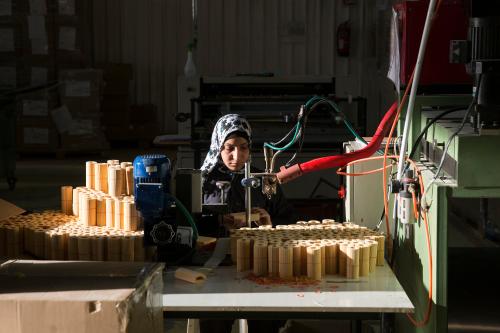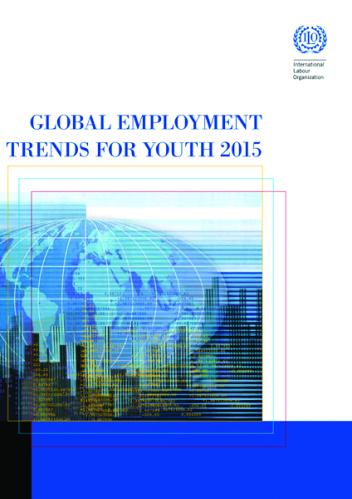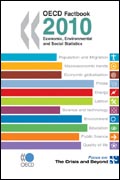About 70 percent of Jordanians are under the age of 29. While in some scenarios this statistic might reflect a strong workforce and an economic opportunity for the country, in Jordan this is not the case—because one out of three of those youth are unemployed. The youth bulge has left young people frustrated and unable to become economically active members of society, without the dignity and sense of worth that they desire.
Women and girls are especially affected. Female participation in Jordan’s workforce is extremely low; indeed at 15 percent it is the lowest in the region. Female unemployment stands at 46 percent compared to 23 percent for men. Jordan’s female literacy rate is among the highest in the Middle East—97.3 percent—and females achieve higher grades than males in almost all levels of education, yet they are notably absent in the workforce. Jordan may have achieved gender parity in education, but equal opportunities for girls in education are not translated into equal opportunities in the economy. If Jordan does not close this gender gap in its workforce, it is not just its women that will miss out on valuable opportunities for personal fulfillment and financial independence, but the country will face a reduced potential GDP growth of 0.5 to 0.9 percent per year. Jordan will miss out on the “growth premium” that female employment can yield to per capita income.
While there has been a steady increase in the Jordan’s capacity to provide employment opportunities to its youth, there is still a lot of work to be done when it comes to engaging females in the workforce.
Over the past ten years, my work has focused on bridging the education and employment gap by providing youth with job-readiness training. At the Jordan Career Education Foundation (JCEF), we found that, of the 757 females that graduated from our demand-driven vocational training program in 2011, 471 (or 63 percent) rejected the vocation sector jobs offered to them—jobs mainly in the garment industry, food manufacturing, hospitality and cosmetology. Further evaluation and in-depth focus group discussion revealed that the deep-rooted explanations behind their drop-outs were cultural constraints. In many cases a woman’s decision to join the workforce was made by the male members of the family. Moreover, somewhat surprisingly, observations showed that younger men are becoming even more stringent in their role as economic providers and authoritative household members. A female living in a family headed by the grandfather or the father has greater likelihood to join the workforce than her counterpart living in a family headed by brothers or husband.
The Jordanian government’s employment strategy recognizes this issue, by indicating that almost 2 million out of the 3.5 million Jordanians of working age are inactive. Furthermore, 54 percent of that inactive population are “stay-at-home females,” and high school is the maximum level of their education attainment.
There is strong political will for change in Jordan to ensure greater gender economic integration. The Ministry of Labor has begun to aggressively tackle “barriers to entry” by providing benefits and incentives, including the provision of day care centers at job locations and of maternity leave pay. Yet most of these interventions have been focused on fixing the demand side (or, the labor market side) of the problem, while little attention has been paid to constraints on the supply side. So despite good effort, there remain unspoken, lingering cultural issues that continue to deter females from entering the workforce.
What has been overlooked by Jordanian policymakers is the potential for preventative measures embedded within the education system. Specifically, the messages implied to youth at school about women and economics have facilitated the current situation. For decades, education scholars have pointed to the role that the “hidden curriculum” plays in reinforcing gender inequality, undermining any formal attempt at challenging dominant gender norms and attitudes. A recent paper by UNESCO even stated that “gender bias in the curriculum is the best camouflage and hardest rock to budge in movements toward gender equality.” As of yet, the Jordanian education system has not been thoroughly evaluated for such biases, especially with regard to content on gender and economics.
To get us started, three specific questions need to be raised:
- What messages are being communicated by the Jordanian curriculum about women and economics, and how can the curriculum be revised to promote female participation in the workforce and improve attitudes towards women in the workforce?
- What are ways in which management, educators and teachers can become responsive to gender discrimination and serve as models of equality?
- What can be done to ensure that gender sensitive policies are implemented in areas of curriculum development to promote greater equality?
As part of my work as an Echidna Scholar at the Center for Universal Education, I will analyze the gender sensitivity of Jordan’s education system with regard to women and economics. I plan to review the national textbooks in select subjects and grades and objectively determine the extent to which the curriculum promotes gender equality in both knowledge about, and experiences pertaining to women in the workforce. A review of leadership modeling within the Ministry of Education at the teachers and management levels will follow. Ultimately, my research aims to offer Jordan’s Ministry of Education a road map to improving female participation in the labor force by instituting educational reforms that improve gender sensitivity.
As gender bias is removed from curricula, specifically in regards to economics, women will be better able to evaluate different options available for them in the labor market.
Educated choices become more possible as women consider moving into tertiary education or making other decisions about their future. Women will become more aware of their rights as both economic providers and social contributors.
Simultaneously, it is expected that with positive gender messaging, especially when representing males and females in non-conventional economic roles, young males will become more accepting of the division of labor both at the workplace and in the household. This effort needs to be coupled with the growth of female leaders who can act as role models. As more female leaders emerge in the education sector, young girls will feel that their accomplishments can be real, and it is then that they will feel assured that opportunities exist for them.
Currently, Jordanian women are not just under glass ceilings at work, but also trapped behind glass doors in their homes. It is often said that education is the springboard for human development. Let us use education as a springboard to shatter these glass barriers for women to enter into a world of free choice.
This blog is authored by one of the Echidna Global Scholars, who spend four to six months researching global education issues as visiting fellows at the Center for Universal Education at the Brookings Institution.








Commentary
Lifting the Barriers for Economic Progress of Women in Jordan
September 15, 2014